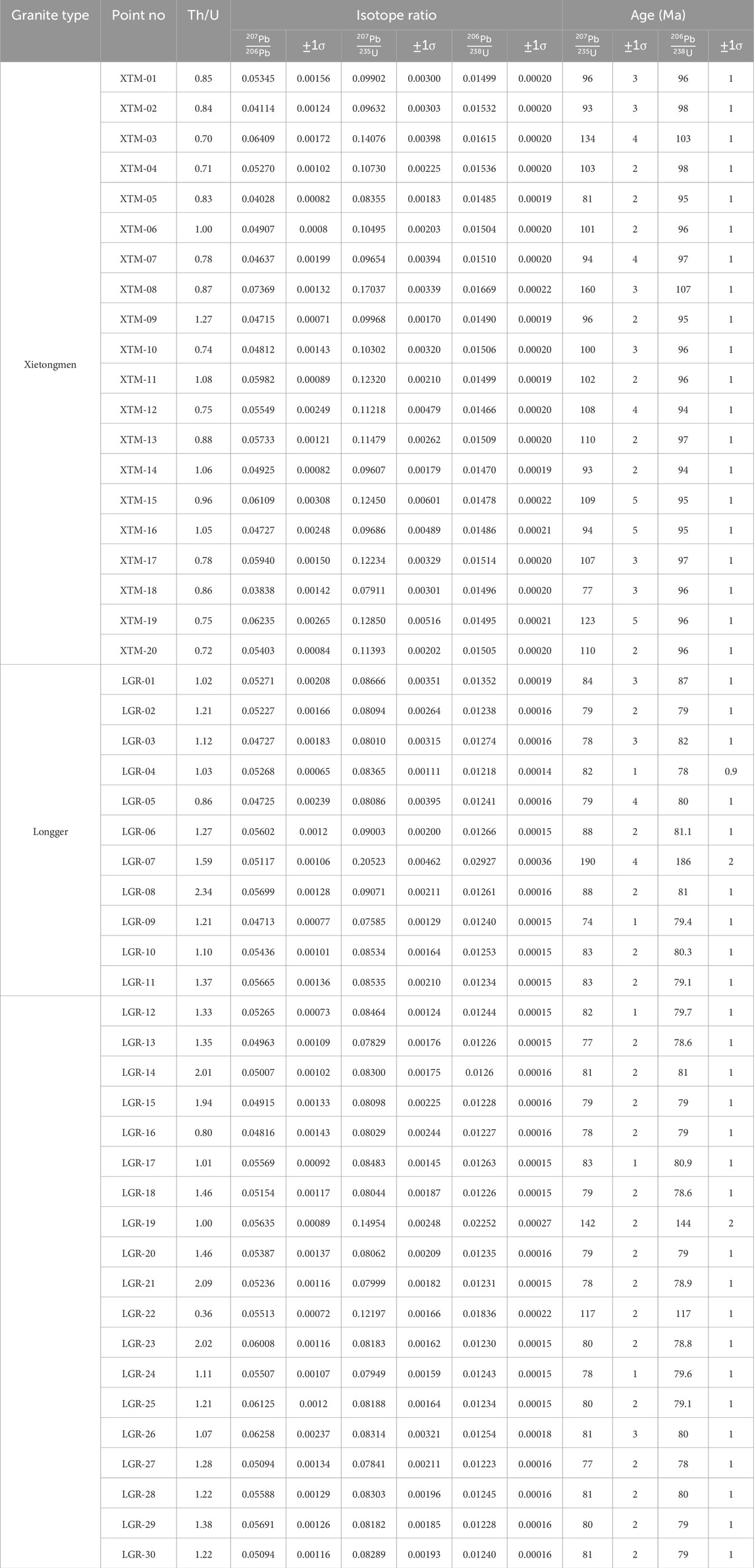- 1School of Earth Sciences, Key Laboratory of Mineral Resources in Western China (Gansu Province), Lanzhou University, Lanzhou, China
- 2The Senior School Affiliated to Chengdu Institute of Education Science (Sichuan Province), The Senior School of Education Science, Chengdu, China
Introduction: The Gangdese Tectonic Belt was formed through the prolonged subduction and collisional processes involving the Neo-Tethys Ocean and the Indian and Asian continental plates, preserving tectonic evolutionary imprints of both oceanic subduction and continental collision. However, the geodynamic mechanisms controlling Late Cretaceous magmatism in the Gangdese Tectonic Belt remain debated, necessitating further investigation into its magmatic evolution and geodynamic processes.
Methods: This study employs zircon U-Pb geochronology and geochemical analysis (including major, trace element, and Sr-Nd isotope data) on the Xietongmen granite and Longger granite from the Gangdese Tectonic Belt.
Results: The Xietongmen granite formed at 96 Ma, while the Longger granite formed slightly later at 80 Ma. The Xietongmen granite can be classified as a high-K calc-alkaline and weakly peraluminous granite. Geochemically, it is enriched in Sr, depleted in Y, and exhibits high Sr/Y and (La/Yb)N ratios, displaying geochemical signatures comparable to adakite-like rocks. The Longger granite is a metaluminous granitoid of the high-K calc-alkaline series. Furthermore, the negative correlation of P2O5 with SiO2 and the presence of hornblende and biotite indicate that it belongs to the I-type granites. The Xietongmen and Longger granites were probably derived from the partial melting of the lower crust. The source of the Xietongmen granite may contain residual garnet and hornblende, while the Longger granite likely underwent plagioclase fractional crystallization. The initial (87Sr/86Sr)i ratios and εNd(t) values (2.78–3.76) of the Xietongmen granite may suggest derivation from a juvenile crustal source.
Discussion: Integrating the data of this study with previous research, the Xietongmen granite was likely formed due to Neo-Tethyan oceanic ridge subduction. In contrast, the Longger granite was formed during the slab rollback phase following ridge subduction.
1 Introduction
Situated in the southwestern region of China, the Tibetan Plateau represents the highest and youngest plateau on the planet, often referred to as the “Roof of the World” (Yin and Harrison, 2000; Chung et al., 2003; Chung et al., 2005; Hou et al., 2013; Hou et al., 2015; Kapp et al., 2005; Kapp et al., 2007; Ji et al., 2009; Ji et al., 2014; Lee et al., 2012; Xu et al., 2015; Zhu et al., 2013; Ding et al., 2014; Wang et al., 2014; Gibbons et al., 2015). It records the sequential opening and closure of multiple oceanic basins within the Tethyan tectonic domain during the Phanerozoic, preserving intricate geological records of multi-stage subduction, collision, and orogenic processes (Zhang et al., 2012; Ingalls et al., 2016; Webb et al., 2017; van Hinsbergen et al., 2019; Qasim et al., 2018; Baral et al., 2019; Rowley, 2019; Tang et al., 2023; Zhu et al., 2023).
The Gangdese Tectonic Belt (GTB) in the southern Tibetan Plateau is one of the most intensely deformed orogenic belts due to complex tectonic-magmatic interactions and crust-mantle processes. Its formation records the evolutionary history of the Neo-Tethys Ocean (Zhu et al., 2013; Ding et al., 2014; Wang et al., 2014; Wang et al., 2016; Ma et al., 2019), preserving extensive geological evidence of the subduction and closure of the Neo-Tethyan Ocean, the continental collision between the Indian and Eurasian plates, and post-collisional magmatic activities (Wen et al., 2008a; Wen et al., 2008b; Ji et al., 2009; 2014; Zhu et al., 2011; Zhu et al., 2018; Xu et al., 2020). Therefore, investigations of the magmatic rocks within the Gangdese Tectonic Belt provide critical constraints for deciphering the formation and evolution of the Neo-Tethys Ocean and the underlying geodynamic mechanisms driving plateau uplift.
The GTB predominantly comprises magmatic rocks formed since the Late Cretaceous (Wen et al., 2008a; Wen et al., 2008b; Ji et al., 2009; Ji et al., 2014). Studies indicate that the Late Cretaceous represents a critical period for transforming subduction mechanisms in the Neo-Tethyan Ocean. This tectonic process induced regional large-scale magmatic activity, leading to the widespread outcropping of Late Cretaceous magmatic rocks in the Gangdese tectonic belt. Magmatic rocks of this period are predominantly intrusive and dominated by diorite and granodiorite (Ji et al., 2009; Ji et al., 2014; Ma et al., 2013a; Ma et al., 2013b; Zhang S et al., 2014; Xu et al., 2015). However, the deep dynamic mechanisms for the genesis of Late Cretaceous rocks in the Gangdese tectonic belt remain controversial, with three main models proposed: (1) flat-slab subduction of the Neo-Tethyan Ocean (Wen et al., 2008a; Wen et al., 2008b); (2) slab rollback of the Neo-Tethyan Ocean (Ma et al., 2013b); and (3) subduction of the Neo-Tethyan mid-ocean ridge (Zhang et al., 2010; Zheng et al., 2014). Each model has a certain degree of validity but requires further geological evidence for validation. Therefore, the complexity of the formation mechanisms of Late Cretaceous magmatic rocks in the Gangdese tectonic belt warrants more in-depth investigation and discussion.
To advance our understanding of the current debate, this study presents zircon U-Pb geochronological data, whole-rock major and trace element compositions, and Sr-Nd isotope data for the Late Cretaceous granites in the central and western segments of the GTB, Tibetan Plateau. Combined with previous research results, we systematically discuss the petrogenesis of these granites and their tectonic settings. The results provide new petrological insights into the formation and evolution of the Neo-Tethys Ocean during the Late Cretaceous in the GTB.
2 Geological setting
Tectonically, the Tibetan Plateau is composed of four major blocks arranged from south to north: the Himalayan block, the Lhasa block, the Qiangtang block, and the Songpan-Ganzi block, with their boundaries delineated by the Indus-Yarlung Zangbo Suture Zone (IYZSZ), the Bangong-Nujiang Suture Zone (BNSZ), and the Jinsha River Suture Zone (JSSZ) (Schärer et al., 1984; Yin and Harrison, 2000; Chu et al., 2006; Guo et al., 2011; Zhu et al., 2011; Zhu et al., 2013). The Gangdese Tectonic Belt, corresponding to the Lhasa terrane, is situated between the BNSZ and the IYZSZ, extending east-west (Yin and Harrison, 2000; Zhu et al., 2011). This belt is characterized by extensive magmatic activity (Figure 1A), forming a vast tectonic-magmatic belt. Throughout its evolution, the GTB has preserved geological records associated with its formation and evolutionary history (Ji et al., 2009; Ran et al., 2019; Zhu et al., 2017; Collins et al., 2020; DePaolo et al., 2019; Ducea et al., 2021). As such, it serves as a natural laboratory for investigating the subduction and collisional dynamics of the Neo-Tethys Ocean.
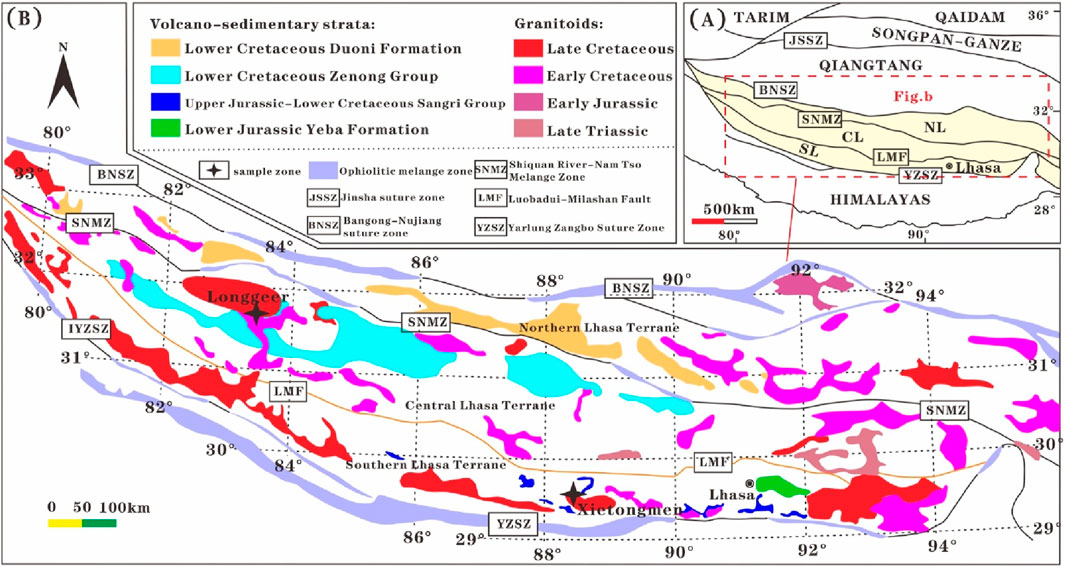
Figure 1. (A) Tectonic structure of the Tibetan Plateau. (B) Spatial distribution of the Gangdese magmatic belt with sample locations. [(A,B) modified after Zhu et al., 2011].
Notable volcanic sequences exposed within the Gangdese tectono-magmatic belt include the Early to Middle Jurassic Yeba Group volcanic rocks (Zhu et al., 2008), the Late Jurassic to Early Cretaceous Sangri Group volcanic rocks (Zhu et al., 2009a; Kang et al., 2014), and the Early Cretaceous Zenong and Duoni Group volcanic rocks (Figure 1B). Intrusive rocks within the Gangdese tectonic belt include minor gabbro, dolerite, monzodiorite, and abundant granodiorite and granite (Ji et al., 2009; Ji et al., 2014; Ma et al., 2013a; Ma et al., 2013b), with Late Cretaceous plutonic rocks exhibiting the greatest lithological diversity and the most extensive exposure.
3 Petrography
The Xietongmen granite is grayish-white, exhibiting a porphyaceous texture and massive structure. The dominant phenocrysts include quartz and plagioclase, while the matrix consists of microcrystalline plagioclase and quartz (Figures 2A–C). The quartz phenocrysts are primarily euhedral to subhedral, with grain sizes varying between 5 and 7 mm, constituting 30%–35% of the total composition. The plagioclase phenocrysts exhibit moderate alteration, undergoing sericitization, constituting roughly 25%–30% of the rock. The groundmass constitutes 25%–30% of the rock, with minor amounts of strongly altered biotite, constituting approximately 5%.
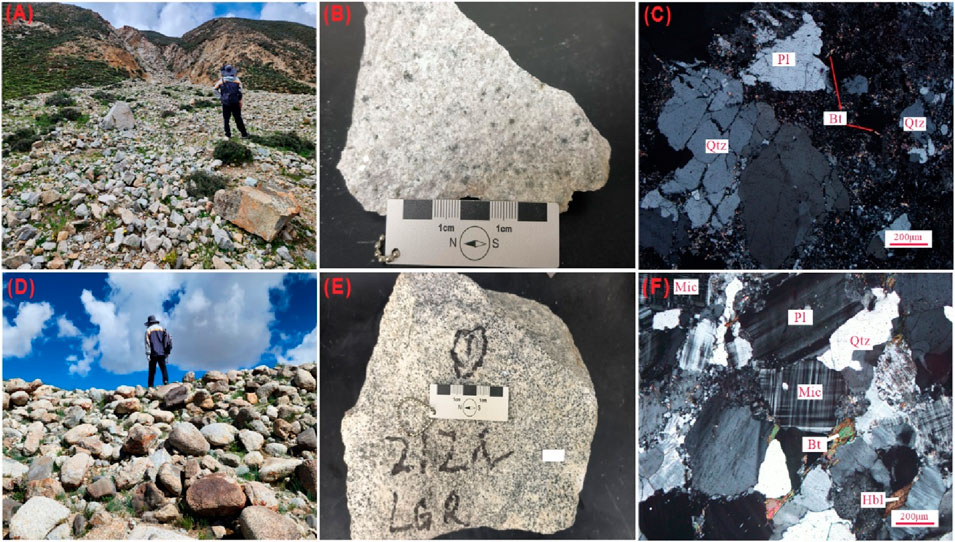
Figure 2. Field outcrops, hand-specimen photographs, and microphotographs of Late Cretaceous magmatic rocks from the Xietongmen area (A–C) and the Longger area (D–F). Abbreviation: Qtz, Quartz; Pl, plagioclase; Kfs, K-feldspar; Mic, microperthite; Hbl, hornblende; Bt, biotite.
The Longger granite is also grayish-white, displaying a medium-to-fine-grained structure with a homogeneous texture (Figures 2D–F). Its primary mineral constituents include microperthite (30%–35%), plagioclase (30%–35%), quartz (15%–20%), biotite (∼5%), and a minor proportion of hornblende (∼5%). Common accessory minerals include zircon, apatite, and iron-rich opaque phases such as magnetite. Microperthite occurs as subhedral to anhedral columnar grains, exhibiting distinct grid twinning. Plagioclase appears as euhedral to subhedral columnar grains, showing well-developed polysynthetic twinning. Quartz is smoky gray, predominantly subhedral to anhedral, having a grain size ranging from 0.2 to 0.5 mm. Biotite forms anhedral flakes, commonly distributed along the margins of other minerals, with evident chloritization. Hornblende is brown, euhedral to subhedral, and is characterized by two sets of inclined cleavages forming an angle of approximately 56°.
4 Analytical methods
Nanjing Hongchuang Geological Exploration Technology Service Co., Ltd. Conducted zircon selection, target preparation, and whole-rock Sr-Nd isotopic analysis. U-Pb isotopic dating of zircons and major and trace element analyses of whole-rock samples were performed at the Key Laboratory of Mineral Resources in Western China, Lanzhou University.
4.1 Zircon U-Pb dating
Initially, the rock samples underwent crushing and washing, and then electromagnetic and heavy liquid separation were applied to concentrate zircon grains. Using a binocular microscope, a selection of well-shaped, larger zircon grains was made and then set in epoxy resin, followed by polishing to prepare analytical mounts. For these polished zircon grains, the most suitable candidates—those exhibiting clear internal zoning without noticeable cracks or bubbles—were selected based on cathodoluminescence (CL), transmission, and reflection imaging. These zircons were then analyzed using laser ablation inductively coupled plasma mass spectrometry (LA-ICP-MS) on an Agilent 7500a ICP-MS system, using a 30 μm laser spot diameter with He as the carrier gas. The reference standards NIST 91500 and NIST 610 were employed for instrumental calibration. Finally, data processing and plotting were conducted using the Glitter and Isoplot software packages.
4.2 Whole-rock geochemical analysis
Major element concentrations were determined using a Leeman Prodigy inductively coupled plasma optical emission spectrometer (ICP-OES). Before analysis, the samples were cleaned, dried, and powdered, then subjected to high-temperature ignition at 1,000°C for 2 h in a crucible. The mass difference before and after heating was recorded to calculate the loss on ignition (LOI). The samples were subsequently fused with lithium metaborate (LiBO2), and the resulting solutions were transferred into volumetric flasks, diluted to a predetermined volume, and weighed for subsequent analysis. For trace element analysis, a high-temperature and high-pressure closed digestion method was employed for sample preparation, followed by analysis using an Agilent 7,700X inductively coupled plasma mass spectrometer (ICP-MS). Whole-rock Sr-Nd isotopic measurements were performed using a Nu Instruments Nu Plasma II MC–ICP–MS device. BCR-2 and AGV-2 were used as external standards, while GSB was employed to monitor Nd isotope measurements.
5 Results
5.1 Zircon U-Pb ages
The zircon U-Pb dating results for the samples from the Xietongmen and Longger granites are presented in Table 1.
The zircon grains extracted from the Xietongmen granite are highly euhedral and predominantly prismatic, with grain sizes ranging from 30 to 150 μm and aspect ratios of 1:1 to 3:1. They show clear magmatic oscillatory zoning in the Cathodoluminescence (CL) images (Figure 3A). The Th/U ratios range from 0.67 to 1.27, aligning with the characteristics of magmatic zircons (Hoskin and Ireland, 2000). Among the 20 zircon spots analyzed for U-Pb isotopes, spots 3 (103 ± 1 Ma) and 8 (107 ± 1 Ma) yielded older ages, suggesting that they are inherited zircons. The remaining 18 zircon spots exhibit a relatively concentrated age distribution on the U-Pb concordia diagram (Figure 4A). The weighted mean 206Pb/238U age of these zircons is 95.9 ± 0.6 Ma (MSWD = 1.3), representing the crystallization age of the Xietongmen granite formed in the Late Cretaceous.
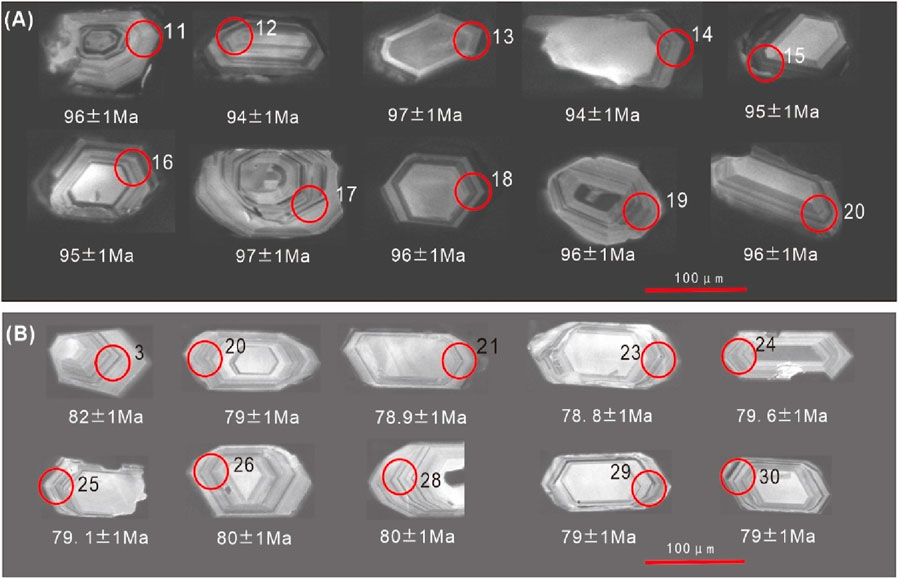
Figure 3. Cathodoluminescence (CL) images and U-Pb age (Ma) analysis of representative zircon grains for the Xietongmen granite (A) and Longer granite (B).
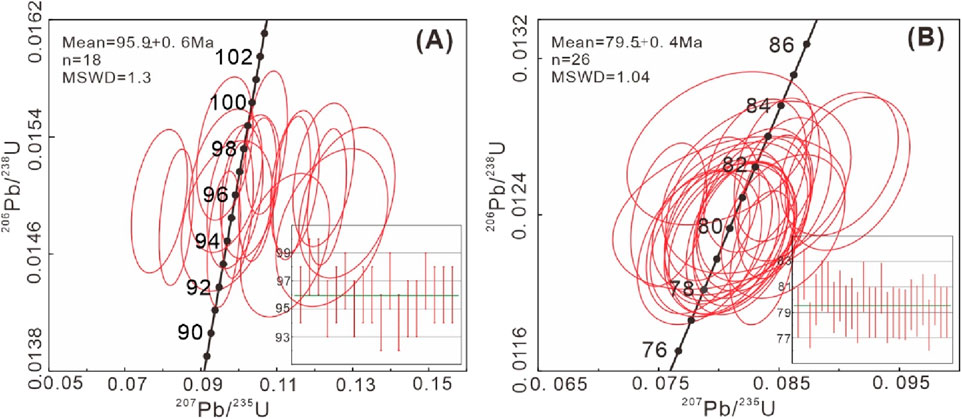
Figure 4. Zircon U-Pb concordia diagrams and weighted ages for the Xietongmen granite (A) and Longer granite (B).
Similar to the Xietongmen granite, the Longger granite contains highly euhedral zircon grains, mostly prismatic, with grain sizes ranging from 50 to 150 μm and aspect ratios of 1:1 to 3:1. Their CL images display clear magmatic oscillatory zoning (Figure 3B). The Th/U ratios range from 0.36 to 2.34, consistent with the characteristics of magmatic zircons (Hoskin and Ireland, 2000). Among the 30 zircon spots analyzed, spots 1, 7, 19, and 22 yielded older ages, suggesting that they are inherited zircons. The remaining 26 spots exhibit a relatively concentrated age distribution on the U-Pb concordia diagram (Figure 4B). The weighted mean 206Pb/238U age of these zircons is 79.5 ± 0.4 Ma (MSWD = 1.04), representing the crystallization age of the Late Cretaceous Longger granite.
5.2 Major and trace elements
Whole-rock major and trace-element compositions of the Xietongmen and Longger granites are presented in Table 2.
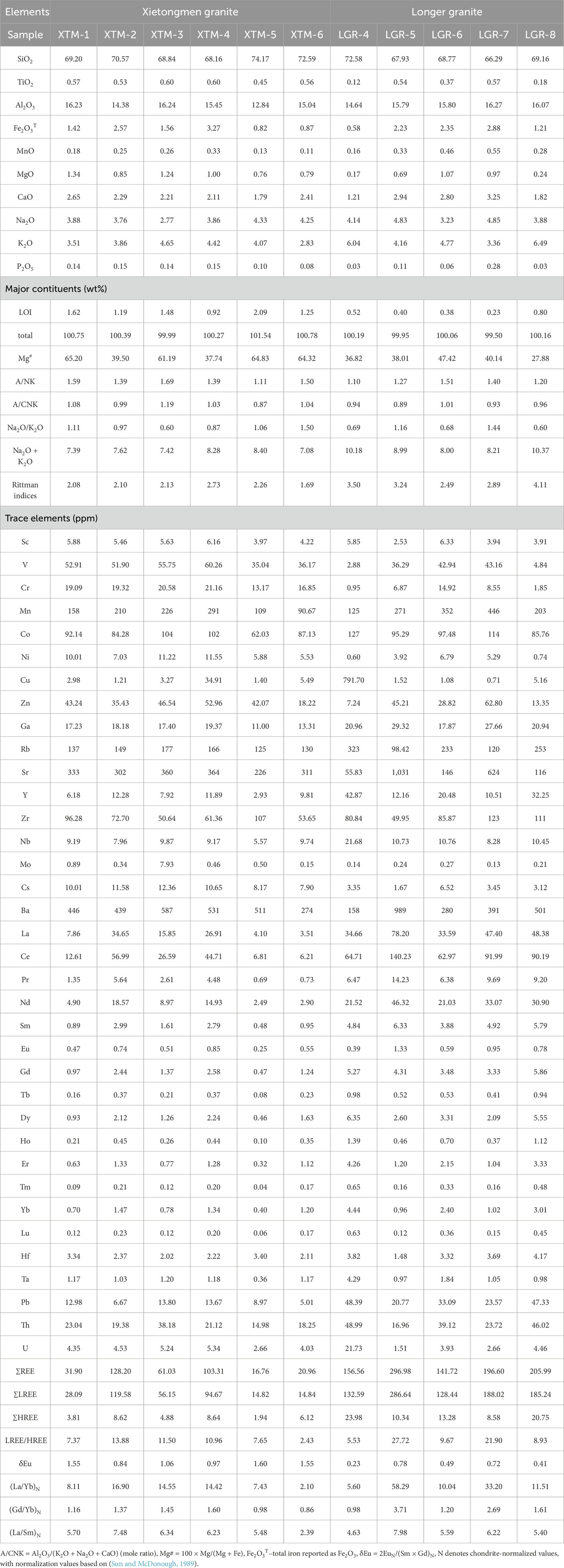
Table 2. Whole-rock geochemical data of granites from Xietongmen and Longer regions (major elements: wt%; trace elements: ppm).
All samples from the Xietongmen granite exhibit comparatively low LOIs (0.92–2.09 wt%). They are characterized by high SiO2 (68.16–74.17 wt%), Al2O3 (12.84–16.24 wt%), K2O (2.83–4.65 wt%), Na2O (2.77–4.33 wt%) contents, and low CaO (1.79–2.65 wt%), TiO2 (0.45–0.60 wt%), P2O5 (0.08–0.15 wt%), MgO (0.76–1.34 wt%) contents. The total alkali (Na2O + K2O) contents vary between 7.08 wt% and 8.40 wt%, and the Rittmann indices (σ = 1.69–2.73) remain below 3.3.
Longger granite samples have low LOIs (0.23–0.80 wt%), high SiO2 (66.29–72.58 wt%), K2O (3.36–6.49 wt%), Na2O (3.23–4.85 wt%), Al2O3 (14.64–16.27 wt%) contents, and low Fe2O3T (0.58–2.88 wt%), MgO (0.17–1.07 wt%, Mg# = 27.88–47.42) contents. Total alkali contents range from 8.00 to 10.37 wt%, and Rittmann indices vary between 2.49 and 4.11.
In the K2O + Na2O versus SiO2 diagram (Figure 5A), all Xietongmen granite samples plot within the granite field, and most Longger granite samples fall into the quartz monzonite field. In the K2O versus SiO2 diagram (Figure 5B), most Xietongmen and Longger granites plot within the high-K calc-alkaline field. In the A/NK versus A/CNK diagram (Figure 5C), most Xietongmen samples fall into the weakly peraluminous field, whereas Longger samples are predominantly metaluminous. Thus, the Xietongmen granite exhibits high-K calc-alkaline and weakly peraluminous geochemical characteristics, while the Longger granite is characterized by high-K calc-alkaline and metaluminous characteristics.
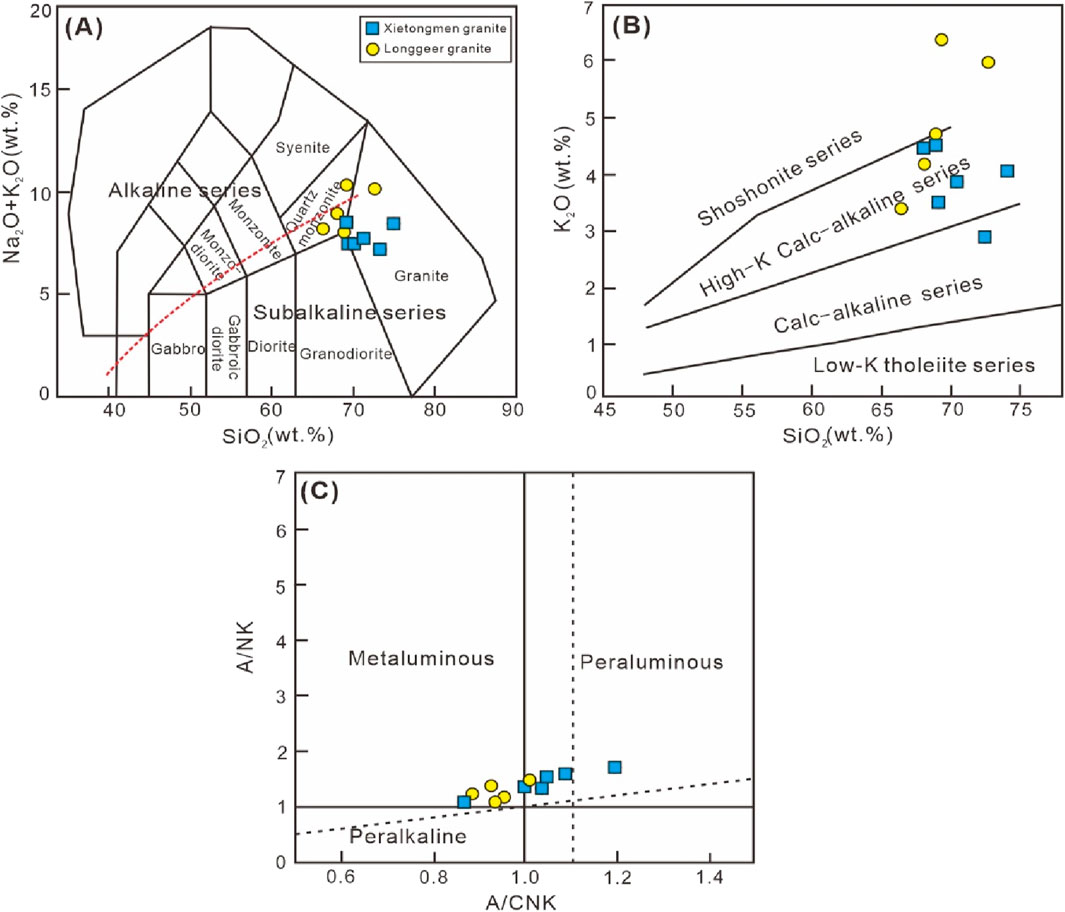
Figure 5. Geochemical diagrams of granites in Xietongmen and Longer area (A) Total alkali (Na2O + K2O) versus silica (SiO2) diagram (Middlemost, 1994); (B) K2O versus SiO2 diagram (Rickwood, 1989); (C) A/NK versus A/CNK diagram (Maniar and Piccoli, 1989).
Regarding trace elements, the total rare earth element (∑REE) concentrations of the Xietongmen granite samples range from 16.76 ppm to 128.20 ppm, indicating a low concentration. The light REE to heavy REE (∑LREE/∑HREE) ratios vary from 2.43 to 13.88, while the chondrite-normalized (La/Yb)N ratios range from 2.10 to 16.90, indicating significant enrichment of LREE relative to HREE and notable fractionation between the two rare earth groups.
The Longger granite samples show ∑REE concentrations between 141.72 ppm and 296.98 ppm. The LREE/HREE ratios vary between 5.53 and 27.72, and the (La/Yb)N values vary between 5.60 and 58.29, showing strong LREE enrichment and fractionation between LREE and HREE.
Both the Xietongmen granite and Longger granite exhibit similar chondrite-normalized rare earth element (REE) patterns (Figures 6A,C), characterized by significant enrichment in LREEs and strong depletion in HREEs, with a rightward-sloping trend in the chondrite-normalized REE pattern. The primitive mantle-normalized multi-element spider (Figures 6B,D) diagram demonstrates that the Xietongmen and Longger granite samples exhibit enrichment in K, Rb, Th, U, and Pb, while showing depletion in Nb, Ta, Ti, and P.
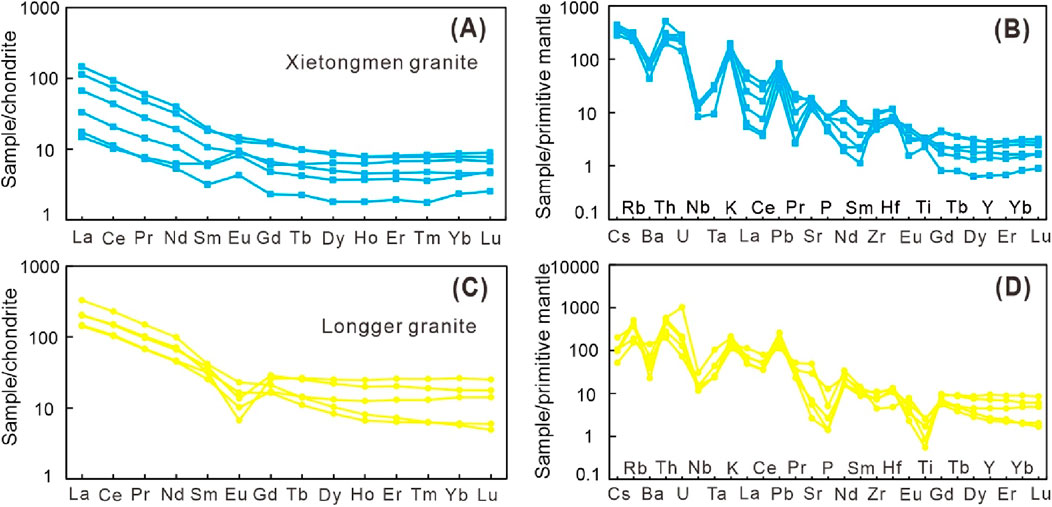
Figure 6. The chondrite-normalized rare earth element (REE) patterns (A,C) and primitive mantle-normalized trace element spider diagrams (B,D) for granites from the Xietongmen and Longger areas, respectively. The normalization values for chondrite and primitive mantle are from Sun and McDonough (1989).
5.3 Sr-Nd isotope systems
Whole-rock Sr–Nd isotopic compositions for the Xietongmen granite samples are listed in Table 3. Based on the granite’s crystallization age of 96 Ma, the 87Sr/86Sr ratios range from 0.706045 to 0.706255, and initial 87Sr/86Sr ratios [(87Sr/86Sr)i] vary between 0.7042 and 0.7044. The 143Nd/144Nd values range from 0.512744 to 0.512781, and initial 143Nd/144Nd ratios [(143Nd/144Nd)i] range from 0.512657 to 0.512707. The εNd (t = 96 Ma) values vary between +2.78 and +3.76, and all of the samples have relatively young two-stage Nd model ages (TDM2) that vary between 591 and 670 Ma. The five granite samples analyzed exhibit positive εNd(t) values, with a narrow range of variation (within one ε unit), indicating a relatively homogeneous magma source.
6 Discussion
6.1 Petrogenesis of the xietongmen adakite
The Xietongmen granite samples are characterized by high SiO2 (68.16–74.17 wt%), Al2O3 (12.82–16.24 wt%), Sr (226–364 ppm), low MgO (0.76–1.34 wt%), Y (2.93–12.28 ppm), and Yb (0.40–1.47 ppm) contents, and corresponding high Sr/Y (24.59–77.13) and La/Yb (2.10–16.90) ratios. All samples display LREE enrichment and depletion in HREEs and HFSEs (such as Nb and Ta), with slightly positive Eu anomalies. These geochemical features are comparable to those of adakitic rocks (Defant and Drummond, 1990; Castillo, 2006), which are generally defined by Al2O3 ≥ 15 wt%, MgO ≤3 wt% (rarely exceeding 6 wt%), Y < 18 ppm, Yb ≤ 1.9 ppm, Sr > 400 ppm, Sr/Y > 20, with slightly positive Eu anomalies (Defant and Drummond, 1990; Castillo, 2006).In the Sr/Y versus Y (Figure 7A) and (La/Yb)N versus YbN (Figure 7B) diagrams, the Xietongmen granite samples are positioned within the adakite field, showing that they have an adakitic geochemical signature.
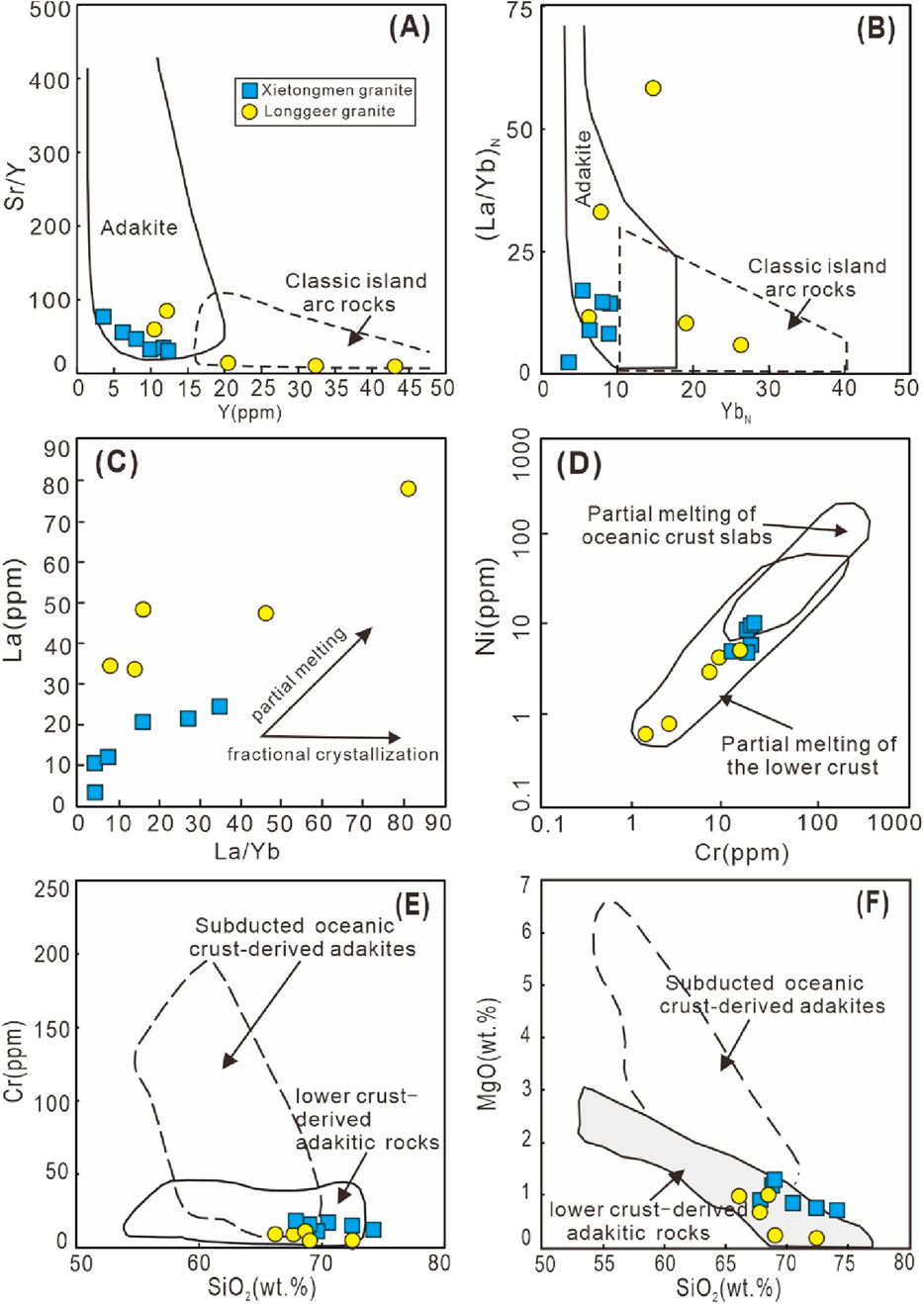
Figure 7. (A) Sr/Y vs. Y diagram (Defant and Drummond, 1990); (B) (La/Yb)N vs. YbN diagram (Martin, 1999); (C) La vs. La/Yb diagram (Furman and Graham, 1999); (D) Ni vs. Cr diagram (Wang et al., 2006); (E) Cr vs. SiO2 diagram (Wang et al., 2006); (F) MgO vs. SiO2 diagram (Wang et al., 2006).
Adakite was initially regarded as derived from the partial melting of a young subducted oceanic slab (Defant and Drummond, 1990). However, recent studies propose several possible formation mechanisms for adakite, as follows: (1) partial melting of subducted oceanic crust (Rapp et al., 1999; Zhu et al., 2009b); (2) partial melting of thickened lower continental crust (Atherton and Petford, 1993; Hou et al., 2013); (3) partial melting of subducted continental crust (Wang et al., 2008); (4) fractional crystallization of primary basaltic magma (Macpherson et al., 2006).
Adakite derived from the fractional crystallization of primary basaltic magma typically leads to a distinct negative Eu anomaly and positive correlations between Sr/Y, Dy/Yb, La/Yb, and SiO2 (Macpherson et al., 2006). However, the Xietongmen adakitic rock has no such characteristics. In the La versus La/Yb plot (Figure 7C), its geochemical signature is more consistent with partial melting than fractional crystallization. Therefore, the formation of the Xietongmen adakitic rock cannot be attributed to fractional crystallization.
Adakitic rocks formed by partial melting of subducted continental crust typically exhibit higher Th/Ba and Rb/Ba ratios, and negative εNd(t) values (Lai and Qin, 2013). However, Xietongmen adakitic rock samples have low Th/Ba (0.03–0.07), Rb/Ba (0.24–0.48) ratios, and positive εNd(t) values (2.78–3.76). Moreover, the Xietongmen adakitic rock formed at 95.9 Ma during the northward subduction of the Neo-Tethyan oceanic lithosphere beneath the Eurasian continent, rather than during the subduction of continental crust. Therefore, this interpretation is also ruled out.
Adakitic rocks derived from partial melting of a subducted oceanic slab typically have low K2O content (Defant and Drummond, 1990). The samples of Xietongmen adakitic rock have comparatively high K2O (2.83–4.65 wt%), similar to the K2O contents (2.9–4.1 wt%) of adakitic rocks derived from lower crustal melting (Defant and Drummond, 1990). Their Nb/Ta ratios (7.71–15.43) are also close to those of continental crust (11–14) (Taylor and McLennan, 1995). Furthermore, all samples of the Xietongmen adakitic rock have low MgO (0.76–1.34 wt%), Cr (13.17–21.16 ppm), and Ni (5.53–11.55 ppm) contents. In the Ni versus Cr (Figure 7D), the Cr versus SiO2 (Figure 7E), and MgO versus SiO2 (Figure 7F) diagrams, most samples fall within the lower crust partial melting field. In the εNd(t) versus 87Sr/86Sr plot (Figure 8), the specimens fall within the adakitic field associated with the thickened magnesian lower crust of southern Tibet.
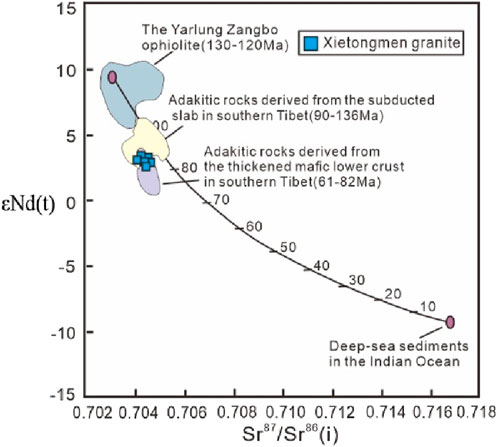
Figure 8. εNd (t) vs. 87Sr/86Sr diagram of the Xietongmen granite (Xu et al., 2020).
The Xietongmen adakite samples exhibit enrichment in LILEs and LREEs, showing depletion in HFSEs. These samples exhibit relatively low initial 87Sr/86Sr isotopic values (0.7042–0.7044) and positive εNd(t) values (+2.78 to +3.76), with two-stage Nd model ages of 591–670 Ma, indicating that the pluton likely derived from the partial melting of a juvenile lower crust. Additionally, Y/Yb ratios (7.42–10.14; ≈10) and (Ho/Yb)N ratios (0.73–0.93; ≈1) suggest that amphibole was the principal residual phase in the magma source, with some residual garnet also present (Hu et al., 2014). The high Ba and Sr contents and the slightly positive Eu anomalies suggest that plagioclase did not remain as a residual phase in the source region. The relatively high Mg# values (> 40) of some samples suggest minor involvement of mantle-derived material during magma evolution. The specimens plot within the crust and mantle field in the (La/Yb) N versus δEu diagram (Figure 9). Therefore, the magma evolution of the Xietongmen adakitic rock was primarily controlled by partial melting, with a residual mineral assemblage dominated by amphibole and garnet, and lacking plagioclase. The geochemical features suggest that the Xietongmen adakite was likely generated through the partial melting of a juvenile thickened lower crust, with a slight input from mantle-sourced components.
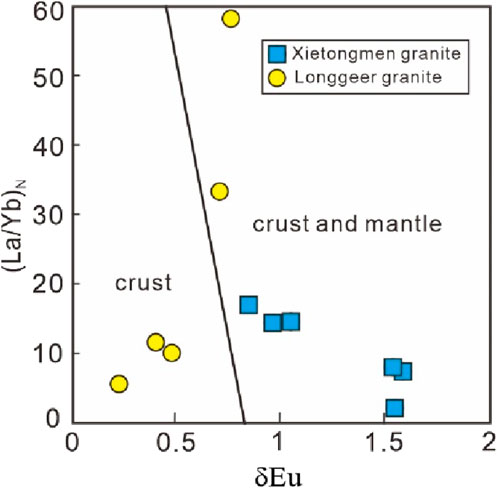
Figure 9. (La/Yb)N vs. δEu diagram (Zhang Z et al., 2014).
6.2 Petrogenesis of the Longger granite
Granites can be categorized into I-, S-, A-, and M-type according to their origin and geological setting (Champion and Chappell, 1992; Chappell and White, 1992). M-type granites formed by fractional crystallization of mantle-derived magma and typically exhibit geochemical characteristics of high Mg# (50–60) values and low SiO2 (<65 wt%) contents (Bowden et al., 1979), whereas the Longger granite displays properties of high SiO2 (66.29–72.58 wt%) contents and low Mg# (27.88–47.42) values, thus excluding its classification as an M-type granite. The samples exhibit Zr + Nb + Ce + Y concentrations ranging from 180 ppm to 245 ppm and an alkalinity index (AI) of 0.50–0.70, which do not correspond to A-type granites (typically Zr + Nb + Ce + Y ≥ 350 ppm, AI > 0.85) (Whalen et al., 1987; Eby, 1990), thus excluding an A-type granite classification. In the (Na2O + K2O)/CaO versus (Zr + Nb + Ce + Y) (Figure 10A) and the Fe2O3T/Mg versus (Zr + Nb + Ce + Y) (Figure 10B) diagrams, the Longger granite plots within the OTG (undifferentiated I, S, M-type granites) granite fields, suggesting that it could be either I-type or S-type granite. The Longger granite is also metaluminous, with an A/CNK ratio of 0.89–1.01. This ratio is below the threshold of 1.1 that distinguishes S-type granite (A/CNK >1.1) and is more consistent with I-type granite (Whalen et al., 1987; Chappell and White, 1992).
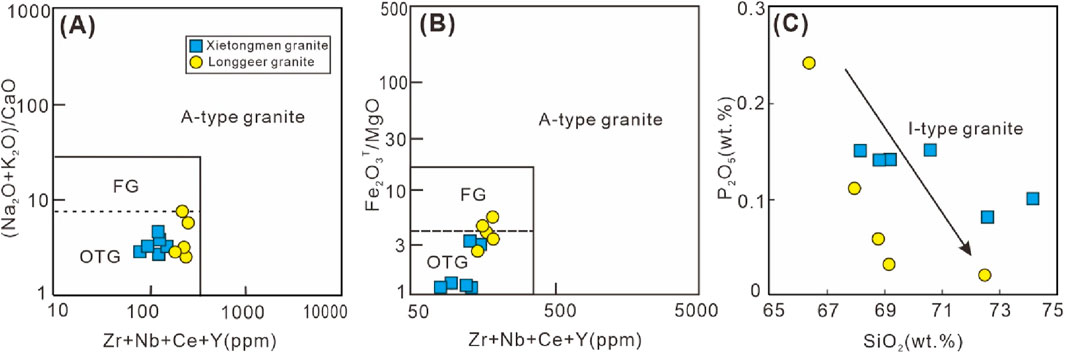
Figure 10. (A) (Na2O + K2O)/CaO vs. (Zr + Nb + Ce + Y) diagram (Whalen et al., 1987); (B) Fe2O3T/Mg vs. (Zr + Nb + Ce + Y) diagram (Whalen et al., 1987); (C) P2O5 vs. SiO2 diagram. Abbreviations: FG, highly fractionated I-type granites; OTG, undifferentiated I, S, M-type granites.
Previous research has indicated that P2O5, Th, Y, Rb, and other major and trace elements can effectively differentiate I-type and S-type granites (Whalen et al., 1987; Wolf and London, 1994). In S-type granites, P2O5 content increases or remains constant with increasing SiO2 (Whalen et al., 1987; Wolf and London, 1994), whereas in I-type granites, it decreases as SiO2 increases. Furthermore, I-type granites typically exhibit high concentrations of Th and Y, with Th showing a positive correlation with Rb (Chappell, 1999). The Longger granite samples exhibit a clear negative correlation in the P2O5 versus SiO2 scatter plot, indicating an evolutionary trend characteristic of I-type granites (Figure 10C). Petrographic analysis shows that hornblende, a characteristic mineral of I-type granite, is also present in these samples. The Longger granite is classified as an I-type granite based on these geochemical and mineralogical features.
I-type granite has been widely regarded as formed through three genetic processes: (1) fractional crystallization of mantle-derived basaltic magma (Cawthorn and Brown, 1976; Wyborn et al., 1987); (2) fractional crystallization of crust-mantle hybrid magma (Turpin et al., 1990; Barbarin, 1996; Chappell et al., 2012); (3) partial melting of the lower crust heated by mantle magma underplating (Castro et al., 1991). I-type granites formed by the first way typically exhibit large-scale coeval basic rocks in their vicinity. However, no extensive basic rocks have been found in the study area. In the La-La/Yb diagram (Figure 7C), the Longger granite exhibits a partial melting trend rather than a fractional crystallization trend. Therefore, the Longger granite was not likely formed by the first one. For the second process, granites formed by crust-mantle mixing typically contain mafic microgranular enclaves, whereas no such dark enclaves have been found in the Longger granite (Turpin et al., 1990; Barbarin, 1996; Chappell et al., 2012). Additionally, the Mg# values of the Longger granite samples range from 27.88% to 47.42% (mean 38.05%), which do not exhibit the high Mg# values indicative of interaction with the mantle (Rapp et al., 1999; Hu et al., 2012). Therefore, the Longger granite was not formed in the second way.
The Longger granite samples exhibit high SiO2 (66.29%–72.58 wt%) and Al2O3 (14.64 wt.%–16.27 wt%) contents. They are enriched in K, Rb, Th, U, and Pb, while displaying depletion in Nb, Ta, Ti, and P, indicating a dominantly continental crustal source (Hu et al., 2017). The Th/U ratios (2.3–11.2, mean 8.5) are comparable to those of the lower crust (6.0) (Rudnick and Gao, 2003). As two high-field-strength elements (HFSEs) with similar incompatibility, Nb and Ta remain relatively stable during magmatic evolution, making them effective indicators of magmatic source characteristics and plutonic evolution (Pfänder et al., 2007). All samples of the Longger granite Nb/Ta ratios (5.06–11.06) are lower than those of the depleted mantle (∼17) but comparable to those of the continental lower crust (∼11) (Pfänder et al., 2007). In the (La/Yb)N versus δEu diagram (Figure 9), most rock specimens fall within the crustal-type granite region, further supporting a lower crustal origin (Rapp and Watson, 1995; Rudnick and Fountain, 1995). Additionally, the La versus La/Yb (Figure 7C) diagram indicates a distinct partial melting trend, and the Ni versus Cr (Figure 7D), Ni versus SiO2 (Figure 7E), and MgO versus SiO2 (Figure 7F) diagrams suggest derivation from lower crustal partial melting. The granite exhibits negative Eu anomalies (δEu = 0.23–0.78) and Ba, Sr depletion characteristics, indicating that it may have undergone plagioclase fractional crystallization (Chappell and White, 1992). In summary, the Longger granite was formed by partial melting of the lower crust. During its magmatic evolution and pluton emplacement, it underwent plagioclase fractional crystallization.
6.3 Tectonic setting and significance
Further insights into the tectonic setting can be derived using granite tectonic classification diagrams (Pearce et al., 1984). In the Fe2O3T/(Fe2O3T + MgO) versus SiO2 diagram (Figure 11A), the specimens plot in the island arc granite, continental arc granite, and collisional granite fields. The Rb versus Y + Nb diagram (Figure 11B) places all specimens in the volcanic arc granite field, while the Nb/Zr versus Zr diagram (Figure 11C) indicates a subduction-related setting. Additionally, most samples plot within the active continental margin field in the Th/Yb versus Ta/Yb diagram (Figure 11D). Combining these geochemical characteristics with geochronological data and the contemporaneous tectonic background of Late Cretaceous magmatism, it is evident that both the Xietongmen and Longger granites were emplaced in a subduction-related environment, likely linked to the northward subduction of the Neo-Tethyan oceanic plate beneath the Eurasian continent.
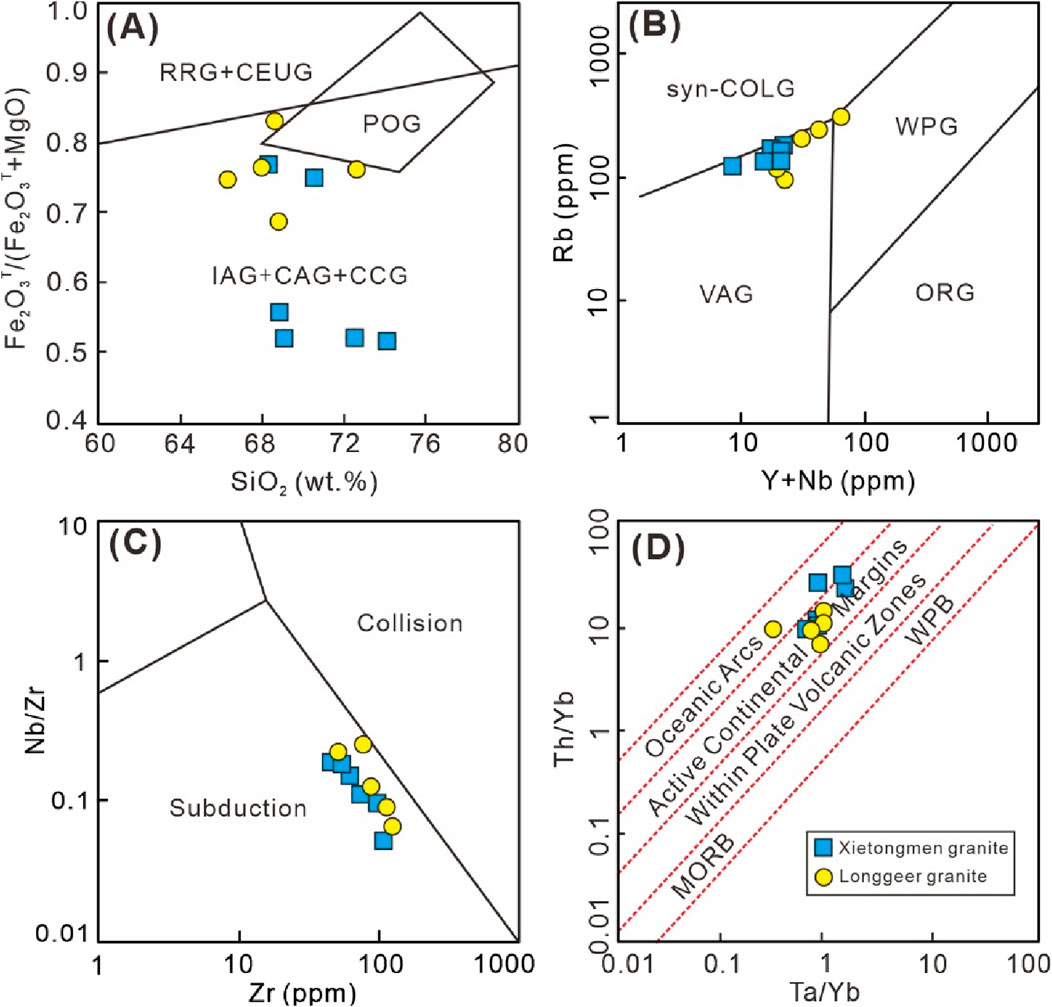
Figure 11. (A) Fe2O3T/(Fe2O3T + MgO) vs. SiO2 diagram (Rollinson H., 1993); (B) Rb vs. (Y + Nb) diagram (Pearce et al., 1984); (C) Nb/Zr vs. Zr diagram (Pearce et al., 1984); (D) Th/Yb vs. Ta/Yb diagram(Schandl and Gorton, 2002). Abbreviations: IAG, Island Arc Granite; CAG, Continental Arc Granite; CCG, Continental Collision Granite; RRG, Rift-Related Granite; CEUG, Continental Epeirogenic Uplift Granite; POG, Post-Collisional Granite; Syn-COLG, Syn-Collisional Granite; VAG, Volcanic Arc Granite; WPG, Within-Plate Granite; ORG, Ocean Ridge Granite.
The Late Cretaceous igneous rocks within the Gangdese Tectonic Belt are interpreted as the result of large-scale magmatic activity triggered by the subduction of the Neo-Tethyan oceanic plate beneath the Lhasa Block (Murphy, 2019; Tassara et al., 2020; van Hinsbergen et al., 2021; Moyen et al., 2021; Luffi and Ducea, 2022). However, the specific subduction dynamics of the Neo-Tethyan Ocean during this period remain debated, with three prevailing models: (1) flat-slab subduction of the Neo-Tethyan Ocean (Coulon et al., 1986; Wen et al., 2008a; Wen et al., 2008b; Zheng et al., 2014); (2) slab rollback of the Neo-Tethyan oceanic lithosphere (Chung et al., 2005; Ma et al., 2013a; Ma et al., 2013b); (3) ridge subduction of the Neo-Tethyan oceanic lithosphere (Zhang et al., 2010; Zhu et al., 2013).
Wen et al. (2008a), Wen et al. (2008b) collected 25 samples from different regions of the Gangdese tectonic belt, including diorite, granodiorite, gabbro, and granite. Samples emplaced between 103 and 80 Ma were selected for systematic geochemical analysis, and data previously published by Quidellieur et al. (1997) were compiled. The results show that most Late Cretaceous samples exhibit adakitic geochemical characteristics. However, adakitic magmatism likely had a short duration, occurring only over a limited period in a specific tectonic domain. This indicates that the Neo-Tethyan Ocean underwent flat-slab subduction during the Late Cretaceous, followed by slab rollback. In general, flat subduction leads to the expulsion of mantle wedge materials due to compressive forces from the subducting slab, resulting in reduced mantle wedge materials in the subduction zone and thereby inhibiting the formation of mantle-derived mafic magmas. This mechanism is inconsistent with the widespread mafic magmatism reported in the early Late Cretaceous (Gutscher and Peacock, 2003; Kapp et al., 2005; Kapp et al., 2007; Kay et al., 2005; Xu et al., 2015; Zhu et al., 2018).
Ma et al. (2013a), Ma et al. (2014) discovered norites and hypersthene-bearing hornblendites emplaced at ∼93 Ma in the Milin area of the southern Gangdese tectonic belt. Geochemical and isotopic data for both rock types indicate that their parental magmas were likely derived from the interaction between upwelling asthenospheric mantle and metasomatized lithospheric mantle (Ma et al., 2013a; Ma et al., 2014). Therefore, they proposed that the early Late Cretaceous magmatic “flare-up” event was triggered by asthenospheric mantle upwelling caused by rollback of the subducted Neo-Tethyan oceanic slab. If the slab rollback mechanism is valid, the oceanic plate should retreat in the direction opposite to subduction. Consequently, magmatic rocks formed during this period should exhibit a progressively younger age trend from north to south. However, such a trend is not observed in the Gangdese Tectonic Belt (Zhu et al., 2009b; Zhu et al., 2018; Zheng et al., 2014).
Zhang et al. (2010) reported high-temperature charnockites formed at 86–90 Ma in the eastern Gangdese Tectonic Belt. Combining coeval calc-alkaline magmatism with the crystallization temperature (900°C) and pressure (1.0 GPa) of the high-temperature adakitic charnockites, they proposed that these high-temperature and low-H2O activity charnockites formed during the subduction of the Neo-Tethyan mid-ocean ridge. Subsequent studies have further supported this model, offering plausible explanations for various geological observations (Zhu et al., 2013; Xu et al., 2015).
Guo et al. (2011), Guo et al. (2013) divided magmatic events in the Gangdese Belt into five stages through zircon U-Pb dating, among which the mid-ocean ridge subduction stage occurred at 89–80 Ma. Based on fieldwork in the Medog-Bomi area, Pan et al. (2014) proposed that the subduction of the mid-ocean ridge beneath the Lhasa Terrane occurred at ∼ 95–80 Ma. Zheng et al. (2014) argued that the subduction of the Neo-Tethyan mid-ocean ridge beneath the southern Lhasa Terrane occurred at 105–76 Ma, based on the presence of high-temperature granulite-facies metamorphism and Late Cretaceous basalt basement in the Langxian area, and the resultant heat accumulation caused melting of the overlying crust, leading to a magmatic peak. Ma et al. discovered hypersthene-bearing hornblendites formed at ∼93 Ma in the Milin area, whose pressure-temperature (P-T) conditions are consistent with the mid-ocean ridge subduction model. Therefore, for the subduction model of the Neo-Tethyan Ocean during the Late Cretaceous, it can be inferred that a northward mid-ocean ridge subduction regime operated in the early Late Cretaceous.
Most of the above studies also support the southward retreat of the subducting Neo-Tethyan slab beneath the southern Lhasa Terrane during the late Late Cretaceous. However, discrepancies remain regarding the timing of slab rollback, primarily whether it occurred before ∼70 Ma (Chung et al., 2005; Zhang et al., 2010; Ma et al., 2013a; Ma et al., 2013c) or after 70 Ma (Lee et al., 2009; Lee et al., 2012). Therefore, the approximate timing of Neo-Tethyan slab retreat remains unclear (Zhu et al., 2009a; Zhu et al., 2018; Zheng et al., 2014).
These studies show that during the mid-ocean ridge subduction of the Neo-Tethyan Ocean, high-temperature asthenospheric material upwelled through slab windows within the subducted oceanic ridge. These thermal anomalies transferred heat to the lithospheric mantle, raising its temperature. The heated lithospheric mantle then transferred heat to the overlying thickened lower crust, inducing partial melting and ultimately triggering large-scale magmatism. The Xietongmen adakitic rock was likely generated as a product of ridge subduction during this period (Figure 12A). It originated through the partial melting of a thickened lower crust and did not experience significant fractional crystallization. Therefore, its geochemical signatures can serve as an indicator for estimating crustal thickness. According to the crustal thickness estimation formula proposed by Chapman et al. (2015):
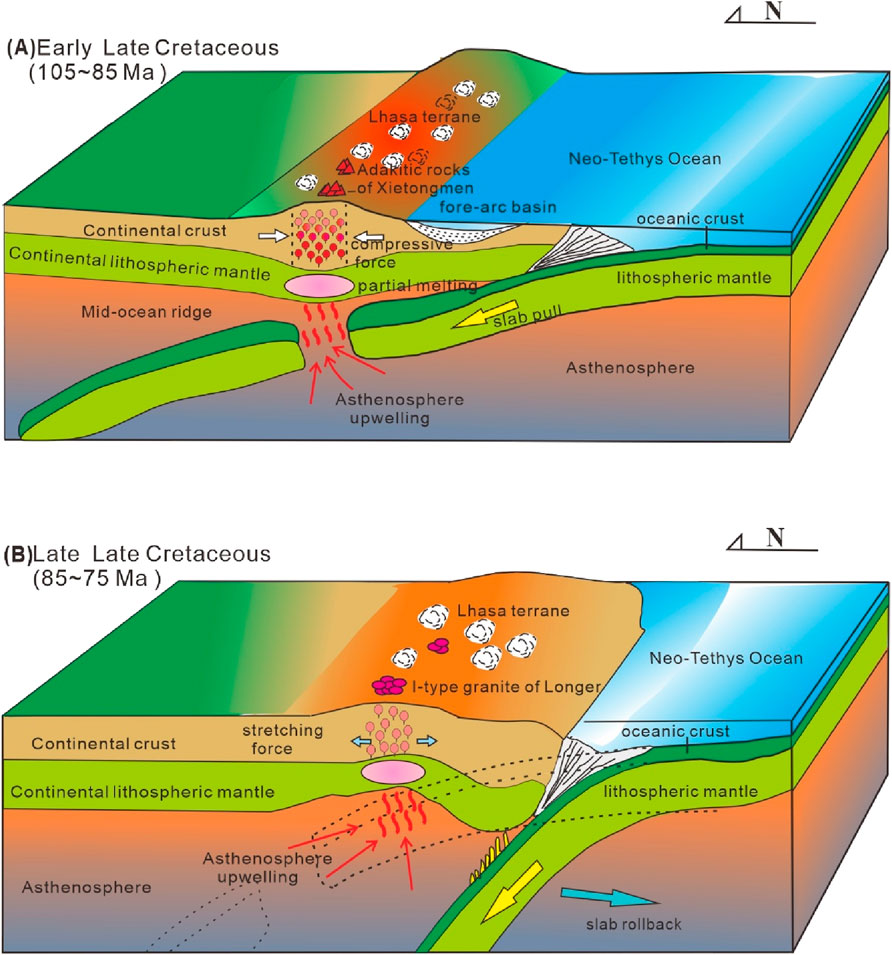
Figure 12. Schematic diagrams of (A) Subduction of the Neo-Tethyan mid-ocean ridge subduction and (B) slab rollback models. (Schematic diagram modified after Suo et al., 2019; Ma et al., 2021).
The Sr/Y values of the selected samples were used to estimate the corresponding crustal thickness, adhering to the applicable range of the formula and the data exclusion criteria. The results show that the median Sr/Y value of the Xietongmen adakitic rock samples is 45.47, yielding an estimated crustal thickness of 49.87 km. Additionally, using the formula proposed by Hu et al. (2017):
The estimated crustal thickness is 54.10 km. The consistency between these two estimates suggests that the crustal thickness of the Gangdese Tectonic Belt reached approximately 50 km in the early Late Cretaceous. This calculation result aligns with the conclusion of Zhu et al. (2023) based on a comprehensive analysis of petrological, geochemical, and geochronological data, which states that “the Gangdese crust experienced local thickening at ∼90 Ma.”
Calculating with Equations 1, 2, the estimated crustal thickness for forming the Longger I-type granite is 33.74 km and 43.86 km. Both values are lower than those for the Xietongmen adakitic rock, suggesting that the Longger I-type granite formed in a relatively extensional setting with a thinner crust, in contrast to the thickened crustal environment of the Xietongmen adakitic rock.
Thus, the Xietongmen adakitic rock, developed in the early Late Cretaceous of the Gangdese Belt, formed under a crustal thickening regime, while the Longger I-type granite, emplaced in the late Late Cretaceous, formed under conditions of crustal thinning. Ridge subduction likely occurred in the initial phase of the Late Cretaceous, followed by slab rollback in the late Late Cretaceous. The slab rollback facilitated extensive asthenospheric mantle upwelling and underplating, which thermally perturbed the lithospheric mantle. The heated lithospheric mantle subsequently transferred heat to the lower crust, causing partial melting and the formation of Longger I-type granite, which is primarily crustal-derived (Figure 12B). This interpretation is consistent with previous studies on crustal recycling in the Gangdese Belt (Chung et al., 2005; Zhang et al., 2010; Ma et al., 2013a; 2013b). However, this hypothesis requires further testing.
7 Conclusion
(1) Zircon U-Pb age analysis indicates that the Xietongmen granite and Longger granite in the Gangdese Tectonic belt have ages of 95.9 ± 0.6 Ma and 79.5 ± 0.4 Ma, respectively, suggesting that both intrusions were emplaced during the Late Cretaceous.
(2) The Xietongmen granite belongs to the high-K calc-alkaline, metaluminous granite series. Furthermore, the samples are enriched in Sr and depleted in Y, with high Sr/Y and (La/Yb)N ratios, exhibiting geochemical characteristics typical of adakitic rocks. Petrogenetically, this granite originated from the partial melting of the thickened lower crust.
(3) The Longger granite is a metaluminous granitoid of the high-K calc-alkaline series. Geochemically, the pluton exhibits enrichment in large ion lithophile elements (LILE) and depletion in high field strength elements (HFSE), and displays geochemical features of I-type granites. Petrogenetically, it originated from the partial melting of the lower crust.
(4) The Xietongmen granite was likely formed in the early Late Cretaceous in a tectonic environment linked to the subduction of the Neo-Tethyan oceanic ridge. In contrast, the Longger I-type granite was likely emplaced in the late Late Cretaceous, following ridge subduction and during the slab rollback phase.
Data availability statement
The original contributions presented in the study are included in the article/supplementary material, further inquiries can be directed to the corresponding author.
Author contributions
FZ: Conceptualization, Writing – review and editing, Methodology, Writing – original draft. XZ: Software, Data curation, Writing – review and editing, Writing – original draft, Investigation. ZG: Writing – original draft, Software, Data curation. EW: Data curation, Writing – original draft, Investigation. HW: Software, Writing – original draft, Investigation.
Funding
The author(s) declare that financial support was received for the research and/or publication of this article. This work was supported by the Second Qinghai-Tibet Plateau Scientific Expedition and Research Project (No. 2019QZKK0901).
Conflict of interest
The authors declare that the research was conducted in the absence of any commercial or financial relationships that could be construed as a potential conflict of interest.
Generative AI statement
The author(s) declare that no Generative AI was used in the creation of this manuscript.
Publisher’s note
All claims expressed in this article are solely those of the authors and do not necessarily represent those of their affiliated organizations, or those of the publisher, the editors and the reviewers. Any product that may be evaluated in this article, or claim that may be made by its manufacturer, is not guaranteed or endorsed by the publisher.
References
Atherton, M. P., and Petford, N. (1993). Generation of sodium-rich magmas from newly underplated basaltic crust. Nature 362 (6416), 144–146. doi:10.1038/362144a0
Baral, U., Lin, D., Goswami, T. K., Sarma, M., Qasim, M., and Bezbaruah, D. (2019). Detrital zircon U–Pb geochronology of a Cenozoic foreland basin in Northeast India: implications for zircon provenance during the collision of the Indian and Asian plates. Terra nova. 31 (1), 18–27. doi:10.1111/ter.12364
Barbarin, B. (1996). Genesis of the two main types of peraluminous granitoids. Geology 24 (4), 295–298. doi:10.1130/0091-7613(1996)024<0295:GOTTMT>2.3.CO;2
Bowden, P., Bennett, J. N., Whitley, J. E., and Moyes, A. B. (1979). Rare earths in Nigerian mesozoic granites and related rocks. Phys. Chem. Earth 11, 479–491. doi:10.1016/0079-1946(79)90045-4
Castillo, P. R. (2006). An overview of adakite petrogenesis. Chin. Sci. Bull. 51 (3), 257–268. doi:10.1007/s11434-006-0257-7
Castro, A., Moreno-Ventas, I., and de la Rosa, J. D. (1991). H-type (hybrid) granitoids: a proposed revision of the granite-type classification and nomenclature. Earth-Science Rev. 31 (3), 237–253. doi:10.1016/0012-8252(91)90020-G
Cawthorn, R. G., and Brown, P. A. (1976). A model for the formation and crystallization of corundum-normative calc-alkaline magmas through amphibole fractionation. J. Geol. 84 (4), 467–476. doi:10.1086/628212
Champion, D. C., and Chappell, B. W. (1992). Petrogenesis of felsic I-type granites: an example from northern Queensland. Earth Environ. Sci. Trans. R. Soc. Edinb. 83 (1-2), 115–126. doi:10.1017/S026359330000780X
Chapman, J. B., Ducea, M. N., DeCelles, P. G., and Profeta, L. (2015). Tracking changes in crustal thickness during orogenic evolution with Sr/Y: an example from the North American Cordillera. Geology 43 (10), 919–922. doi:10.1130/G36996.1
Chappell, B. W. (1999). Aluminium saturation in I- and S-type granites and the characterization of fractionated haplogranites. Lithos 46 (3), 535–551. doi:10.1016/S0024-4937(98)00086-3
Chappell, B. W., Bryant, C. J., and Wyborn, D. (2012). Peraluminous I-type granites. Lithos 153, 142–153. doi:10.1016/j.lithos.2012.07.008
Chappell, B. W., and White, A. J. R. (1992). I- and S-type granites in the lachlan fold belt. Earth Environ. Sci. Trans. R. Soc. Edinb. 83 (1-2), 1–26. doi:10.1017/S0263593300007720
Chu, M., Chung, S., Song, B., Liu, D., O'Reilly, S. Y., Pearson, N. J., et al. (2006). Zircon U-Pb and Hf isotope constraints on the Mesozoic tectonics and crustal evolution of southern Tibet. Geology 34 (9), 745–748. doi:10.1130/G22725.1
Chung, S., Chu, M., Zhang, Y., Xie, Y., Lo, C., Lee, T., et al. (2005). Tibetan tectonic evolution inferred from spatial and temporal variations in post-collisional magmatism. Earth-Science Rev. 68 (3), 173–196. doi:10.1016/j.earscirev.2004.05.001
Chung, S., Liu, D., Ji, J., Chu, M., Lee, H., Wen, D., et al. (2003). Adakites from continental collision zones: melting of thickened lower crust beneath southern Tibet. Geology 31 (11), 1021–1024. doi:10.1130/G19796.1
Collins, W. J., Murphy, J. B., Johnson, T. E., and Huang, H. (2020). Critical role of water in the formation of continental crust. Nat. Geosci. 13 (5), 331–338. doi:10.1038/s41561-020-0573-6
Coulon, C., Maluski, H., Bollinger, C., and Wang, S. (1986). Mesozoic and cenozoic volcanic rocks from central and southern Tibet:39Ar-40Ar dating, petrological characteristics and geodynamical significance. Earth Planet. Sci. Lett. 79 (3), 281–302. doi:10.1016/0012-821X(86)90186-X
Defant, M. J., and Drummond, M. S. (1990). Derivation of some modern arc magmas by melting of young subducted lithosphere. Nature 347 (6294), 662–665. doi:10.1038/347662a0
DePaolo, D. J., Harrison, T. M., Wielicki, M., Zhao, Z., Zhu, D., Zhang, H., et al. (2019). Geochemical evidence for thin syn-collision crust and major crustal thickening between 45 and 32 Ma at the southern margin of Tibet. Gondwana Res. 73, 123–135. doi:10.1016/j.gr.2019.03.011
Ding, L., Xu, Q., Yue, Y., Wang, H., Cai, F., and Li, S. (2014). The andean-type gangdese mountains: paleoelevation record from the paleocene–eocene linzhou basin. Earth Planet. Sci. Lett. 392, 250–264. doi:10.1016/j.epsl.2014.01.045
Ducea, M. N., Chapman, A. D., Bowman, E., and Triantafyllou, A. (2021). Arclogites and their role in continental evolution; part 1: background, locations, petrography, geochemistry, chronology and thermobarometry. Earth-Science Rev. 214, 103375. doi:10.1016/j.earscirev.2020.103375
Eby, G. N. (1990). The A-type granitoids: a review of their occurrence and chemical characteristics and speculations on their petrogenesis. Lithos 26 (1), 115–134. doi:10.1016/0024-4937(90)90043-Z
Furman, T., and Graham, D. (1999). Erosion of lithospheric mantle beneath the East African Rift system: geochemical evidence from the Kivu volcanic province. Lithos 48 (1), 237–262. doi:10.1016/S0024-4937(99)00031-6
Gibbons, A. D., Zahirovic, S., Müller, R. D., Whittaker, J. M., and Yatheesh, V. (2015). A tectonic model reconciling evidence for the collisions between India, Eurasia and intra-oceanic arcs of the central-eastern Tethys. Gondwana Res. 28 (2), 451–492. doi:10.1016/j.gr.2015.01.001
Guo, L., Zhang, H., Harris, N., Pan, F., and Xu, W. (2011). Origin and evolution of multi-stage felsic melts in eastern Gangdese belt: constraints from U–Pb zircon dating and Hf isotopic composition. Lithos 127 (1), 54–67. doi:10.1016/j.lithos.2011.08.005
Guo, L., Zhang, H., Harris, N., Pan, F., and Xu, W. (2013). Late Cretaceous (∼81Ma) high-temperature metamorphism in the southeastern Lhasa terrane: implication for the Neo-Tethys ocean ridge subduction. Tectonophysics 608, 112–126. doi:10.1016/j.tecto.2013.10.007
Gutscher, M., and Peacock, S. M. (2003). Thermal models of flat subduction and the rupture zone of great subduction earthquakes. J. Geophys. Res. Solid Earth 108 (B1), 1–2. doi:10.1029/2001JB000787
Hoskin, P. W. O., and Ireland, T. R. (2000). Rare earth element chemistry of zircon and its use as a provenance indicator. Geology 28 (7), 627–630. doi:10.1130/0091-7613(2000)28<627:REECOZ>2.0.CO;2
Hou, Z., Duan, L., Lu, Y., Zheng, Y., Zhu, D., Yang, Z., et al. (2015). Lithospheric architecture of the Lhasa terrane and its control on ore deposits in the himalayan-Tibetan orogen. Econ. Geol. Geol. 110 (6), 1541–1575. doi:10.2113/econgeo.110.6.1541
Hou, Z., Zheng, Y., Yang, Z., Rui, Z., Zhao, Z., Jiang, S., et al. (2013). Contribution of mantle components within juvenile lower-crust to collisional zone porphyry Cu systems in Tibet. Miner. Deposita 48 (2), 173–192. doi:10.1007/s00126-012-0415-6
Hu, F., Ducea, M. N., Liu, S., and Chapman, J. B. (2017). Quantifying crustal thickness in continental collisional belts: global perspective and a geologic application. Sci. Rep. 7 (1), 7058. doi:10.1038/s41598-017-07849-7
Hu, J., Jiang, S., Zhao, H., Shao, Y., Zhang, Z., Xiao, E., et al. (2012). Geochemistry and petrogenesis of the Huashan granites and their implications for the Mesozoic tectonic settings in the Xiaoqinling gold mineralization belt, NW China. J. Asian Earth Sci. 56, 276–289. doi:10.1016/j.jseaes.2012.05.016
Hu, Z., Yang, X., Duan, L., and Sun, W. (2014). Geochronological and geochemical constraints on genesis of the adakitic rocks in outang, south tan–Lu fault belt (northeastern yangtze block). Tectonophysics 626, 86–104. doi:10.1016/j.tecto.2014.04.004
Ingalls, M., Rowley, D. B., Currie, B., and Colman, A. S. (2016). Large-scale subduction of continental crust implied by India–Asia mass-balance calculation. Nat. Geosci. 9 (11), 848–853. doi:10.1038/ngeo2806
Ji, W., Wu, F., Chung, S., Li, J., and Liu, C. (2009). Zircon U–Pb geochronology and Hf isotopic constraints on petrogenesis of the Gangdese batholith, southern Tibet. Chem. Geol. 262 (3), 229–245. doi:10.1016/j.chemgeo.2009.01.020
Ji, W., Wu, F., Chung, S., and Liu, C. (2014). The Gangdese magmatic constraints on a latest Cretaceous lithospheric delamination of the Lhasa terrane, southern Tibet. Lithos 210-211, 168–180. doi:10.1016/j.lithos.2014.10.001
Kang, Z., Xu, J., Wilde, S. A., Feng, Z., Chen, J., Wang, B., et al. (2014). Geochronology and geochemistry of the Sangri group volcanic rocks, southern Lhasa terrane: implications for the early subduction history of the neo-tethys and gangdese magmatic arc. Lithos 200-201, 157–168. doi:10.1016/j.lithos.2014.04.019
Kapp, P., DeCelles, P. G., Gehrels, G. E., Heizler, M., and Ding, L. (2007). Geological records of the lhasa-qiangtang and indo-asian collisions in the nima area of central Tibet. GSA Bull. 119 (7-8), 917–933. doi:10.1130/B26033.1
Kapp, P., Yin, A., Harrison, T. M., and Ding, L. (2005). Cretaceous-Tertiary shortening, basin development, and volcanism in central Tibet. GSA Bull. Bull. 117 (7-8), 865–878. doi:10.1130/B25595.1
Kay, S. M., Godoy, E., and Kurtz, A. (2005). Episodic arc migration, crustal thickening, subduction erosion, and magmatism in the south-central Andes. GSA Bull. 117 (1-2), 67–88. doi:10.1130/B25431.1
Lai, S., and Qin, J. (2013). Adakitic rocks derived from the partial melting of subducted continental crust: evidence from the Eocene volcanic rocks in the northern Qiangtang block. Gondwana Res. 23 (2), 812–824. doi:10.1016/j.gr.2012.06.003
Lee, H., Chung, S., Ji, J., Qian, Q., Gallet, S., Lo, C., et al. (2012). Geochemical and Sr–Nd isotopic constraints on the genesis of the Cenozoic Linzizong volcanic successions, southern Tibet. J. Asian Earth Sci. 53, 96–114. doi:10.1016/j.jseaes.2011.08.019
Lee, H., Chung, S., Lo, C., Ji, J., Lee, T., Qian, Q., et al. (2009). Eocene Neotethyan slab breakoff in southern Tibet inferred from the Linzizong volcanic record. Tectonophysics 477 (1), 20–35. doi:10.1016/j.tecto.2009.02.031
Luffi, P., and Ducea, M. N. (2022). Chemical mohometry: assessing crustal thickness of ancient orogens using geochemical and isotopic data. Rev. Geophys. 60 (2), e2021RG000753. doi:10.1029/2021RG000753
Ma, L., Wang, B., Jiang, Z., Wang, Q., Li, Z., Wyman, D. A., et al. (2014). Petrogenesis of the Early Eocene adakitic rocks in the Napuri area, southern Lhasa: partial melting of thickened lower crust during slab break-off and implications for crustal thickening in southern Tibet. Lithos 196-197, 321–338. doi:10.1016/j.lithos.2014.02.011
Ma, L., Wang, Q., Li, Z., Wyman, D. A., Jiang, Z., Yang, J., et al. (2013a). Early Late Cretaceous (ca. 93Ma) norites and hornblendites in the Milin area, eastern Gangdese: lithosphere–asthenosphere interaction during slab roll-back and an insight into early Late Cretaceous (ca. 100–80Ma) magmatic “flare-up” in southern Lhasa (Tibet). Lithos 172-173, 17–30. doi:10.1016/j.lithos.2013.03.007
Ma, L., Wang, Q., Wyman, D. A., Jiang, Z., Yang, J., Li, Q., et al. (2013b). Late Cretaceous crustal growth in the Gangdese area, southern Tibet: petrological and Sr–Nd–Hf–O isotopic evidence from Zhengga diorite–gabbro. Chem. Geol. 349-350, 54–70. doi:10.1016/j.chemgeo.2013.04.005
Ma, L., Wang, Q., Wyman, D. A., Li, Z., Jiang, Z., Yang, J., et al. (2013c). Late Cretaceous (100–89Ma) magnesian charnockites with adakitic affinities in the Milin area, eastern Gangdese: partial melting of subducted oceanic crust and implications for crustal growth in southern Tibet. Lithos 175-176, 315–332. doi:10.1016/j.lithos.2013.04.006
Ma, X., Xu, Z., Liu, F., Zhoa, Z., and Li, H. (2021). Episodic magmatism in continental arcs and crustal thickening: a case study of the gangdese arc in southern Tibet. Acta Geol. Sin. 95 (1), 107–123. doi:10.3969/j.issn.0001-5717
Ma, X., Xu, Z., Zhao, Z., and Yi, Z. (2019). Identification of a new source for the Triassic Langjiexue Group: evidence from a gabbro-diorite complex in the Gangdese magmatic belt and zircon microstructures from sandstones in the Tethyan Himalaya, southern Tibet. Geosphere 16 (1), 407–434. doi:10.1130/GES02154.1
Macpherson, C. G., Dreher, S. T., and Thirlwall, M. F. (2006). Adakites without slab melting: high pressure differentiation of island arc magma, Mindanao, the Philippines. Earth Planet. Sci. Lett. 243 (3), 581–593. doi:10.1016/j.epsl.2005.12.034
Maniar, P. D., and Piccoli, P. M. (1989). Tectonic discrimination of granitoids. GSA Bull. 101 (5), 635–643. doi:10.1130/0016-7606(1989)101<0635:TDOG>2.3.CO;2
Martin, H. (1999). Adakitic magmas: modern analogues of Archaean granitoids. Lithos 46 (3), 411–429. doi:10.1016/S0024-4937(98)00076-0
Middlemost, E. A. K. (1994). Naming materials in the magma/igneous rock system. Earth-Science Rev. 37 (3), 215–224. doi:10.1016/0012-8252(94)90029-9
Moyen, J., Janoušek, V., Laurent, O., Bachmann, O., Jacob, J., Farina, F., et al. (2021). Crustal melting vs. fractionation of basaltic magmas: Part 1, granites and paradigms. Lithos 402-403, 106291. doi:10.1016/j.lithos.2021.106291
Murphy, J. B. (2019). Appinite suites and their genetic relationship with coeval voluminous granitoid batholiths. Int. Geol. Rev. 62, 683–713. doi:10.1080/00206814.2019.1630859
Pan, F., Zhang, H., Xu, W., Guo, L., Wang, S., and Luo, B. (2014). U–Pb zircon chronology, geochemical and Sr–Nd isotopic composition of Mesozoic–Cenozoic granitoids in the SE Lhasa terrane: petrogenesis and tectonic implications. Lithos 192-195, 142–157. doi:10.1016/j.lithos.2014.02.005
Pearce, J. A., Harris, N. B. W., and Tindle, A. G. (1984). Trace element discrimination diagrams for the tectonic interpretation of granitic rocks. J. Petrology 25 (4), 956–983. doi:10.1093/petrology/25.4.956
Pfänder, J. A., Münker, C., Stracke, A., and Mezger, K. (2007). Nb/Ta and Zr/Hf in ocean island basalts — implications for crust–mantle differentiation and the fate of Niobium. Earth Planet. Sci. Lett. 254 (1), 158–172. doi:10.1016/j.epsl.2006.11.027
Qasim, M., Ding, L., Khan, M. A., Jadoon, I. A. K., Haneef, M., Baral, U., et al. (2018). Tectonic implications of detrital zircon ages from lesser himalayan mesozoic-cenozoic strata, Pakistan. Geochem. Geophys. Geosystems 19 (5), 1636–1659. doi:10.1002/2017GC006895
Quidelleur, X., Grove, M., Lovera, O. M., Harrison, T. M., Yin, A., and Ryerson, F. J. (1997). Thermal evolution and slip history of the renbu zedong thrust, southeastern Tibet. J. Geophys. Res. Solid Earth 102 (B2), 2659–2679. doi:10.1029/96JB02483
Ran, M., Kang, Z., Xu, J., Yang, F., Jiang, Z., Li, Q., et al. (2019). Evolution of the northward subduction of the neo-tethys: implications of geochemistry of cretaceous arc volcanics in Qinghai-Tibetan plateau. Palaeogeogr. Palaeoclimatol. Palaeoecol. 515, 83–94. doi:10.1016/j.palaeo.2017.12.043
Rapp, R. P., Shimizu, N., Norman, M. D., and Applegate, G. S. (1999). Reaction between slab-derived melts and peridotite in the mantle wedge: experimental constraints at 3.8 GPa. Chem. Geol. 160 (4), 335–356. doi:10.1016/S0009-2541(99)00106-0
Rapp, R. P., and Watson, E. B. (1995). Dehydration melting of metabasalt at 8–32 kbar: implications for continental growth and crust-mantle recycling. J. Petrology 36 (4), 891–931. doi:10.1093/petrology/36.4.891
Rickwood, P. C. (1989). Boundary lines within petrologic diagrams which use oxides of major and minor elements. Lithos 22 (4), 247–263. doi:10.1016/0024-4937(89)90028-5
Rollinson, H. (1993). Using geochemical data: evaluation, presentation, interpretation. Wiley. doi:10.4324/9781315845548
Rowley, D. B. (2019). Comparing paleomagnetic study means with apparent wander paths: a case study and paleomagnetic test of the greater India versus greater Indian basin hypotheses. Tectonics 38 (2), 722–740. doi:10.1029/2017TC004802
Rudnick, R. L., and Fountain, D. M. (1995). Nature and composition of the continental crust: a lower crustal perspective. Rev. Geophys. 33 (3), 267–309. doi:10.1029/95RG01302
Rudnick, R. L., and Gao, S. (2003). “Composition of the continental crust,” in Treatise on geochemistry. Editors H. D. Holland, and K. K. Turekian (Oxford: Pergamon), 1–64. doi:10.1016/B0-08-043751-6/03016-4
Schandl, E. S., and Gorton, M. P. (2002). Application of high field strength elements to discriminate tectonic settings in vms environments. Econ. Geol. 97 (3), 629–642. doi:10.2113/gsecongeo.97.3.629
Schärer, U., Xu, R., and Allègre, C. J. (1984). UPb geochronology of gangdese (transhimalaya) plutonism in the lhasa-xigaze region, Tibet. Earth Planet. Sci. Lett. 69 (2), 311–320. doi:10.1016/0012-821X(84)90190-0
Sun, S. S., and McDonough, W. F. (1989). Chemical and isotopic systematics of oceanic basalts: implications for mantle composition and processes. London: Geological Society of London 7. 42, 313–345. doi:10.1144/GSL.SP.1989.042.01.19
Suo, Y., Li, S., Jin, C., Zhang, Y., Zhou, J., Li, X., et al. (2019). Eastward tectonic migration and transition of the Jurassic-Cretaceous Andean-type continental margin along Southeast China. Earth-Science Rev. 196, 102884. doi:10.1016/j.earscirev.2019.102884
Tang, S., Dong, S., Yang, X., Fan, C., Li, H., Zhong, Z., et al. (2023). Geochemical analysis of dolomite in the fourth member of the upper sinian dengying formation, northern sichuan basin, China. ACS Omega 8 (48), 45878–45895. doi:10.1021/acsomega.3c06638
Tassara, S., Ague, J. J., and Valencia, V. (2020). The deep magmatic cumulate roots of the Acadian orogen, eastern North America. Geology 49 (2), 168–173. doi:10.1130/G47887.1
Taylor, S. R., and McLennan, S. M. (1995). The geochemical evolution of the continental crust. Rev. Geophys. 33 (2), 241–265. doi:10.1029/95RG00262
Turpin, L., Cuney, M., Friedrich, M., Bouchez, J., and Aubertin, M. (1990). Meta-igneous origin of Hercynian peraluminous granites in N.W. French Massif Central: implications for crustal history reconstructions. Contributions Mineralogy Petrology 104 (2), 163–172. doi:10.1007/BF00306440
van Hinsbergen, D. J. J., Lippert, P. C., Li, S., Huang, W., Advokaat, E. L., and Spakman, W. (2019). Reconstructing Greater India: paleogeographic, kinematic, and geodynamic perspectives. Tectonophysics 760, 69–94. doi:10.1016/j.tecto.2018.04.006
van Hinsbergen, D. J. J., Steinberger, B., Guilmette, C., Maffione, M., Gürer, D., Peters, K., et al. (2021). A record of plume-induced plate rotation triggering subduction initiation. Nat. Geosci. 14, 626–630. doi:10.1038/s41561-021-00780-7
Wang, C., Ding, L., Zhang, L., Kapp, P., Pullen, A., and Yue, Y. (2016). Petrogenesis of Middle–Late Triassic volcanic rocks from the Gangdese belt, southern Lhasa terrane: implications for early subduction of Neo-Tethyan oceanic lithosphere. Lithos 262, 320–333. doi:10.1016/j.lithos.2016.07.021
Wang, Q., Wyman, D. A., Xu, J., Dong, Y., Vasconcelos, P. M., Pearson, N., et al. (2008). Eocene melting of subducting continental crust and early uplifting of central Tibet: evidence from central-western Qiangtang high-K calc-alkaline andesites, dacites and rhyolites. Earth Planet. Sci. Lett. 272 (1), 158–171. doi:10.1016/j.epsl.2008.04.034
Wang, Q., Xu, J., Jian, P., Bao, Z., Zhao, Z., Li, C., et al. (2006). Petrogenesis of adakitic porphyries in an extensional tectonic setting, dexing, south China: implications for the genesis of porphyry copper mineralization. J. Petrology 47 (1), 119–144. doi:10.1093/petrology/egi070
Wang, Q., Zhu, D., Zhao, Z., Liu, S., Chung, S., Li, S., et al. (2014). Origin of the ca. 90Ma magnesia-rich volcanic rocks in SE Nyima, central Tibet: products of lithospheric delamination beneath the Lhasa-Qiangtang collision zone. Lithos 198-199, 24–37. doi:10.1016/j.lithos.2014.03.019
Webb, A. A. G., Guo, H., Clift, P. D., Husson, L., Müller, T., Costantino, D., et al. (2017). The Himalaya in 3D: slab dynamics controlled mountain building and monsoon intensification. Lithosphere 9 (4), L636.1–651. doi:10.1130/L636.1
Wen, D., Chung, S., Song, B., Iizuka, Y., Yang, H., Ji, J., et al. (2008). Late Cretaceous Gangdese intrusions of adakitic geochemical characteristics, SE Tibet: petrogenesis and tectonic implications. Lithos 105 (1), 1–11. doi:10.1016/j.lithos.2008.02.005
Wen, D., Liu, D., Chung, S., Chu, M., Ji, J., Zhang, Q., et al. (2008). Zircon SHRIMP U–Pb ages of the gangdese batholith and implications for neotethyan subduction in southern Tibet. Chem. Geol. 252 (3), 191–201. doi:10.1016/j.chemgeo.2008.03.003
Whalen, J. B., Currie, K. L., and Chappell, B. W. (1987). A-type granites: geochemical characteristics, discrimination and petrogenesis. Contributions Mineralogy Petrology 95 (4), 407–419. doi:10.1007/BF00402202
Wolf, M. B., and London, D. (1994). Apatite dissolution into peraluminous haplogranitic melts: an experimental study of solubilities and mechanisms. Geochimica Cosmochimica Acta 58 (19), 4127–4145. doi:10.1016/0016-7037(94)90269-0
Wyborn, D., Turner, B. S., and And Chappell, B. W. (1987). The Boggy Plain Supersuite: a distinctive belt of I-type igneous rocks of potential economic significance in the Lachlan Fold Belt. Aust. J. Earth Sci. 34 (1), 21–43. doi:10.1080/08120098708729392
Xu, Q., Zeng, L., Zhao, L., Hu, Z., Wang, H., Shen, Y., et al. (2020). Geochemical characteristics and petrogenesis of Miocene high Sr/Y rocks in Xigatze fore-arc basin, southern Tibet. Lithos 366-367, 105543. doi:10.1016/j.lithos.2020.105543
Xu, W., Zhang, H., Luo, B., Guo, L., and Yang, H. (2015). Adakite-like geochemical signature produced by amphibole-dominated fractionation of arc magmas: an example from the Late Cretaceous magmatism in Gangdese belt, south Tibet. Lithos 232, 197–210. doi:10.1016/j.lithos.2015.07.001
Xu, Z., Dilek, Y., Cao, H., Yang, J., Robinson, P., Ma, C., et al. (2015). Paleo-tethyan evolution of Tibet as recorded in the east cimmerides and west cathaysides. J. Asian Earth Sci. 105, 320–337. doi:10.1016/j.jseaes.2015.01.021
Yin, A., and Harrison, T. M. (2000). Geologic evolution of the himalayan-Tibetan orogen. Annu. Rev. Earth Planet. Sci. 28 (28), 211–280. doi:10.1146/annurev.earth.28.1.211
Zhang, K., Zhang, Y., Tang, X., and Xia, B. (2012). Late Mesozoic tectonic evolution and growth of the Tibetan plateau prior to the Indo-Asian collision. Earth-Science Rev. 114 (3), 236–249. doi:10.1016/j.earscirev.2012.06.001
Zhang, S., Li, F., Li, Y., Liu, W., and Qin, Y. (2014). Early Ordovician strongly peraluminous granite in the middle section of the Yarlung Zangbo junction zone and its geological significance. Sci. China Earth Sci. 57 (4), 630–643. doi:10.1007/s11430-013-4721-3
Zhang, Z., Dong, X., Xiang, H., He, Z., and Liou, J. G. (2014). Metagabbros of the Gangdese arc root, south Tibet: implications for the growth of continental crust. Geochimica Cosmochimica Acta 143, 268–284. doi:10.1016/j.gca.2014.01.045
Zhang, Z., Zhao, G., Santosh, M., Wang, J., Dong, X., and Shen, K. (2010). Late Cretaceous charnockite with adakitic affinities from the Gangdese batholith, southeastern Tibet: evidence for Neo-Tethyan mid-ocean ridge subduction? Gondwana Res. 17 (4), 615–631. doi:10.1016/j.gr.2009.10.007
Zheng, Y., Hou, Z., Gong, Y., Liang, W., Sun, Q., Zhang, S., et al. (2014). Petrogenesis of Cretaceous adakite-like intrusions of the Gangdese Plutonic Belt, southern Tibet: implications for mid-ocean ridge subduction and crustal growth. Lithos 190-191, 240–263. doi:10.1016/j.lithos.2013.12.013
Zhu, D., Mo, X., Niu, Y., Zhao, Z., Wang, L., Liu, Y., et al. (2009). Geochemical investigation of Early Cretaceous igneous rocks along an east–west traverse throughout the central Lhasa Terrane, Tibet. Chem. Geol. 268 (3), 298–312. doi:10.1016/j.chemgeo.2009.09.008
Zhu, D., Pan, G., Chung, S., Liao, Z., Wang, L., and And Li, G. (2008). SHRIMP zircon age and geochemical constraints on the origin of lower jurassic volcanic rocks from the Yeba formation, southern gangdese, south Tibet. Int. Geol. Rev. 50 (5), 442–471. doi:10.2747/0020-6814.50.5.442
Zhu, D., Wang, Q., Cawood, P. A., Zhao, Z., and Mo, X. (2017). Raising the gangdese mountains in southern Tibet. J. Geophys. Res. Solid Earth 122 (1), 214–223. doi:10.1002/2016JB013508
Zhu, D., Wang, Q., Chung, S., Cawood, P., and Zhao, Z. (2018). Gangdese magmatism in southern Tibet and India–asia convergence since 120 Ma. 483. London: Geological Society of London 483, 583–604. doi:10.1144/SP483.14
Zhu, D., Wang, Q., Weinberg, R. F., Cawood, P. A., Zhao, Z., Hou, Z., et al. (2023). Continental crustal growth processes recorded in the gangdese batholith, southern Tibet. Annu. Rev. Earth Planet. Sci. 51 (51), 155–188. doi:10.1146/annurev-earth-032320-110452
Zhu, D., Zhao, Z., Niu, Y., Dilek, Y., Hou, Z., and Mo, X. (2013). The origin and pre-Cenozoic evolution of the Tibetan Plateau. Gondwana Res. 23 (4), 1429–1454. doi:10.1016/j.gr.2012.02.002
Zhu, D., Zhao, Z., Niu, Y., Mo, X., Chung, S., Hou, Z., et al. (2011). The Lhasa Terrane: record of a microcontinent and its histories of drift and growth. Earth Planet. Sci. Lett. 301 (1), 241–255. doi:10.1016/j.epsl.2010.11.005
Zhu, D., Zhao, Z., Pan, G., Lee, H., Kang, Z., Liao, Z., et al. (2009). Early cretaceous subduction-related adakite-like rocks of the Gangdese Belt, southern Tibet: products of slab melting and subsequent melt–peridotite interaction? J. Asian Earth Sci. 34 (3), 298–309. doi:10.1016/j.jseaes.2008.05.003
Keywords: granitoid, Late Cretaceous, petrogenesis, tectonics, Gangdese Tectonic Belt, Neo-Tethys Ocean
Citation: Zheng F, Zhai X, Guo Z, Wang E and Wang H (2025) Geochemical characteristics and petrogenetic process of late cretaceous granites in the southern Tibet Gangdese Tectonic Belt. Front. Earth Sci. 13:1597623. doi: 10.3389/feart.2025.1597623
Received: 21 March 2025; Accepted: 16 June 2025;
Published: 30 June 2025.
Edited by:
Hu Li, Sichuan University of Science and Engineering, ChinaCopyright © 2025 Zheng, Zhai, Guo, Wang and Wang. This is an open-access article distributed under the terms of the Creative Commons Attribution License (CC BY). The use, distribution or reproduction in other forums is permitted, provided the original author(s) and the copyright owner(s) are credited and that the original publication in this journal is cited, in accordance with accepted academic practice. No use, distribution or reproduction is permitted which does not comply with these terms.
*Correspondence: Xinwei Zhai, emhhaXh3OTI2QGx6dS5lZHUuY24=
 Feifei Zheng
Feifei Zheng Xinwei Zhai1*
Xinwei Zhai1*